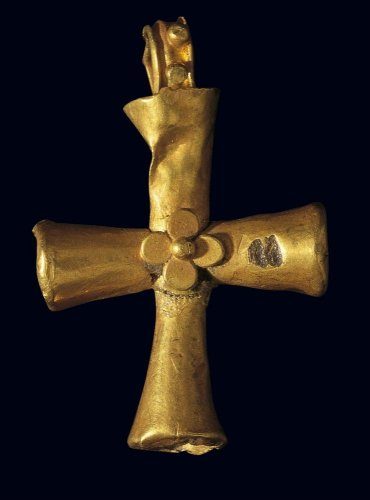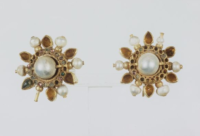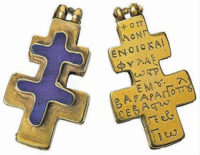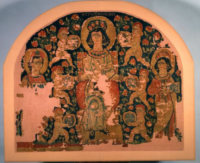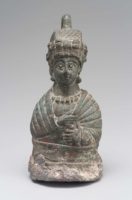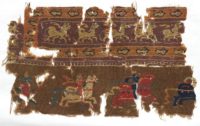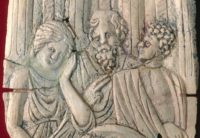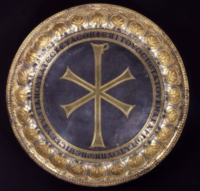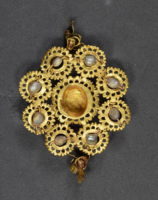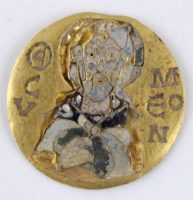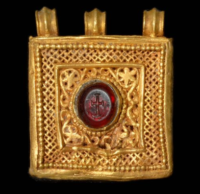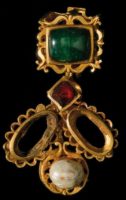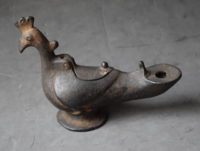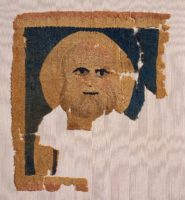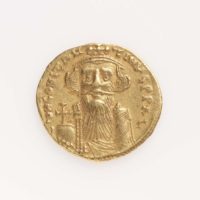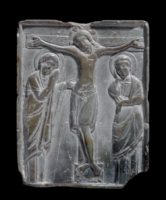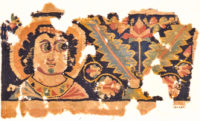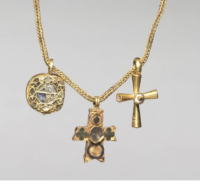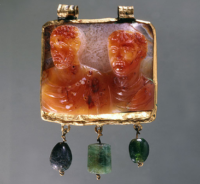Cross, with a decorative quatrefoil rosette at the juncture of the arms. Materials: gold. Period: Early Byzantine; circa: Early 7th c. The Benaki Museum of Greek Culture is housed in one of the most beautiful neoclassical-style buildings in Athens, near the National Garden and the Hellenic Parliament.
Booking.comEarring with Openwork, Period: Middle Byzantine circa: 7th-9th Century. Materials: gold with a rock crystal bead. The Cleveland Art Museum Hours: Tuesdays, Thursdays, Saturdays, Sundays 10:00 a.m.–5:00 p.m. Wednesdays, Fridays 10:00 a.m.–9:00 p.m. Closed Mondays.
Pair of Earrings, Materials: Gold, Gems, Pearls and Garnets. Period: Early Byzantine, circa: early 5th century. The museum is open to the public Tuesday through Sunday, 11:30 a.m.–5:30 p.m., except for federal holidays.
Byzantine Pectoral Cross (front and back), Period: Late Byzantine circa: 1200–1400 A.D. , Benaki Museum, Athens. Museum Description: “Gold pectoral in the form of a Resurrection cross with double horizontal arms set with lapis lazuli. The owner’s name, Georgios Varagkopoulos, is inscribed on the back together with his title Sevastos (Augustus), which reflects his high social standing and explains the luxurious quality of the materials and the fine workmanship. “
The Benaki Museum of Greek Culture is housed in one of the most beautiful neoclassical-style buildings in Athens, near the National Garden and the Hellenic Parliament. It was converted into a museum in order to shelter the collections of Antonis Benakis and was donated to the Greek nation by himself and his three sisters, Alexandra, Penelope and Argine. Following its most recent refurbishment (1989–2000), the building houses a unique exhibition on Greek culture arranged diachronically from prehistory to the 20th century.
Hanging with Hestia Polyolbus, Period: Early Byzantine, First half of 6th Century. The museum is open to the public Tuesday through Sunday, 11:30 a.m.–5:30 p.m., except for federal holidays.
Steelyard weight in the form of a bust of an empress, Period: Early Byzantine Period, circa: 5th century A.D. Material: Bronze. The MFA is open 7 days a week. Monday and Tuesday 10 am–5 pm, Wednesday–Friday 10 am–10 pm, Saturday and Sunday 10 am–5 pm.
Fragment of a Tunic, Period: Early Byzantine; circa: 5th – 7th century; Materials: tapestry weave; wool and linen. The Cleveland Art Museum Hours: Tuesdays, Thursdays, Saturdays, Sundays 10:00 a.m.–5:00 p.m. Wednesdays, Fridays 10:00 a.m.–9:00 p.m. Closed Mondays.
Relief based on story of Achilles receiving his armor on the island of Skyros. Period: Early Byzantine, Material: Ivory. The MFA is open 7 days a week. Monday and Tuesday 10 am–5 pm, Wednesday–Friday 10 am–10 pm, Saturday and Sunday 10 am–5 pm.
Paten with Christogram and Repousse Border, Period: Early Byzantine, circa Mid 6th Century. Materials: silver, gilding and niello. The museum is open to the public Tuesday through Sunday, 11:30 a.m.–5:30 p.m., except for federal holidays.
Pendant; Material: gold. Period: Late Roman; Early Byzantine; (5thc.) Found: Medinet el-Faiyum, Egypt. Open-work; composed of central setting with a stone (now missing), around which are eight small medallions, with a pearl in the middle of each. British Museum is closed 24, 25 and 26 December and 1 January, but is open every other day of the year.
Medallion with a Bust of St Symeon; Period: Middle Byzantine; circa: 10th-11th c. Materials: gold. Dimensions: 0,021 m.
The Benaki Museum of Greek Culture is housed in one of the most beautiful neoclassical-style buildings in Athens, near the National Garden and the Hellenic Parliament. It was converted into a museum in order to shelter the collections of Antonis Benakis and was donated to the Greek nation by himself and his three sisters, Alexandra, Penelope and Argine. Following its most recent refurbishment (1989–2000), the building houses a unique exhibition on Greek culture arranged diachronically from prehistory to the 20th century.
Necklace; Cross pendant; Period: Early Byzantine; 5thc.-6thc.; Materials: glass, amber, amethyst and carnelian beads. Found: Qaw el-Kebir, Egypt, Upper Egypt. British Museum is closed 24, 25 and 26 December and 1 January, but is open every other day of the year.
Reliquary of St. Zacharias, Period: Early Byzantine, 6th Century, Material: Gold and gems. The museum is open to the public Tuesday through Sunday, 11:30 a.m.–5:30 p.m., except for federal holidays.
Three sections of a Gold necklace. Materials: sapphires, emeralds, cornelians and pearls. Period: Early Byzantine; circa: 5th c. Made in: Alexandria, Egypt. Their height varies from 0.05 to 0.06 m. The Benaki Museum of Greek Culture is housed in one of the most beautiful neoclassical-style buildings in Athens, near the National Garden and the Hellenic Parliament.
Hanging lamp; Period: Early Byzantine; (5thC-6thC). Found: Tell el-Yahudiya (Africa,Egypt,Lower Egypt,Nile Delta,Tell el-Yahudiya) Length: 6.24 inchesHeight: 4.75 inches. Material: Bronze. British Museum is closed 24, 25 and 26 December and 1 January, but is open every other day of the year. Fast facts about the British Museum: Founded: 1753, Collection size: 8 million objects, Oldest object in the collection: Stone chopping tool (nearly 2 million years old).
Tapestry panel: Head of a man. Coptic, Egypt. Period: Early Byzantine circa: 4th-5th century A.D. Dimensions: 23.5 x 20 cm (9 1/4 x 7 7/8 in.); Legacy dimension: 23.5 x 20.0 cm. Materials: Wool. The MFA is open 7 days a week. Monday and Tuesday 10 am–5 pm, Wednesday–Friday 10 am–10 pm, Saturday and Sunday 10 am–5 pm.
Solidus of Constans II, Period: Early Byzantine, circa: 651–654. Minted in: Constantinople. Material: Gold. The Museum of Fine Arts, Boston is open 7 days a week. Monday and Tuesday 10 am–5 pm, Wednesday–Friday 10 am–10 pm, Saturday and Sunday 10 am–5 pm.
Relief plaque icon, depicting the Crucifixion with full-length figures of the Virgin on the left and St John on the right, Late Byzantine (13 thc). Materials: Steatite – Gold.
Tapestry fragment Egyptian (Coptic), Period: Early Byzantine, circa: 5th-6th century A.D. Material: silk. The MFA is open 7 days a week. Monday and Tuesday 10 am–5 pm, Wednesday–Friday 10 am–10 pm, Saturday and Sunday 10 am–5 pm.
Chain with Pendant and Two Crosses, Materials: Gold with enamel and glass. Period: Early Byzantine, 500’s. The Cleveland Art Museum Hours: Tuesdays, Thursdays, Saturdays, Sundays 10:00 a.m.–5:00 p.m. Wednesdays, Fridays 10:00 a.m.–9:00 p.m. Closed Mondays.
Busts of Two Emperors, Period: Roman, Circa: Late 3rd-early 4th century, Material: Chalcedony on gold. The museum is open to the public Tuesday through Sunday, 11:30 a.m.–5:30 p.m., except for federal holidays.


